The latest Business Travel Trends Report by Expedia Affiliate Network reveals that employees increasingly expect the same choice, technology and intuitive booking platforms that they find with leisure travel.
from HOTELMARKETING.COM https://ift.tt/2Fvnd64
Monday, April 30, 2018
Business travelers demand leisure booking experience
MGM Resorts taps Expedia to grow package bookings in Vegas
To boost customer acquisition at its properties in Las Vegas, MGM Resorts International is operating its package booking platform using Expedia Powered Technology.
from HOTELMARKETING.COM https://ift.tt/2HFR9OM
Travel content marketing 2018: Top trends + takeaways
Take a look at how some of the biggest names in travel are choosing to connect with their target markets - and the kind of success 2018's top travel content marketing trends can lead to.
from HOTELMARKETING.COM https://ift.tt/2I2v3JK
Introducing hotel campaigns on Google Hotel Ads
Google began the soft rollout of Hotel campaigns on March 8th, marking a major milestone in the ongoing evolution of Google Hotel Ads. Starting in June, Google will completely transition all accounts to this new structure. So, what exactly does this update mean for you?
from HOTELMARKETING.COM https://ift.tt/2HHWANb
New feature on Google Hotel Ads: Occupancy filters
One of the greatest deficiencies that the Google price comparison site had was the absence of the occupancy filter in searches: you could only search for rooms for two people.
from HOTELMARKETING.COM https://ift.tt/2I3MKbK
Study: Consumers will pay for superior brand interactions
A welcoming experience and speedy service rate highly among consumers, who are generally willing to pay a price premium of 16% more when they find these things, according to a PwC study.
from HOTELMARKETING.COM https://ift.tt/2HJErP5
How blockchain could disrupt hotel distribution and loyalty
While it's still too early to know how blockchain technology might change the hospitality industry, experts are starting to share details of what could be effective use cases in distribution and hotel loyalty.
from HOTELMARKETING.COM https://ift.tt/2I0sS9z
Segmentation throughout the guest journey
From the very beginning of the searching process to the post-stay comedown, guests are increasingly expecting an experience that feels tailored, thoughtful and built with them in mind. Let's take a look at the ways hotels can ensure they're equipped to provide it.
from HOTELMARKETING.COM https://ift.tt/2HD9O1u
Signs and Symptoms of Decompression Sickness
Every time we enter the water as scuba divers we're entering an alien environment. There are inherent risks and, no matter what your personal background, qualification or skill level, the laws of physics remain consistent. We all face the possibility of contracting decompression sickness (DCS), also called caisson disease or the bends. What are the signs and symptoms of decompression sickness, and how do we mitigate our risks? Here's what to look for and how you can do your best to avoid it.
When does DCS occur?
Decompression sickness manifests after inadequate decompression following exposure to increased ambient pressure while scuba diving. Some instances are mild and not immediately life-threatening while other instances can be quite serious, even deadly. If you get DCS, the more swiftly you begin treatment, the greater likelihood that you'll recover fully.
Students learn the basics of DCS during initial open-water training. Many factors can predispose you to DCS, including illness, age, alcohol or drug use, extreme heat or cold, old injuries, proneness to blood clotting, obesity, medication, lack of sleep, extreme fatigue and dehydration.
Nitrogen bubbles forming at the joints are the cause of the joint pain experienced in a classical "bend." However, the signs and symptoms of decompression sickness are also quite wide-ranging and, in some cases, divers may confuse them with other causes, leading to an incorrect diagnosis.
Essentially, we break down signs and symptoms into 'Type 1' and 'Type 2.'
Type 1 symptoms of DCS
DCS Type 1 symptoms are generally milder and less immediately critical than Type 2 DCS symptoms.
Type 1 is often identified with musculoskeletal pain, such as the classic pain the joints at the elbow or knee. Alternatively, or sometimes in addition, they may also include skin symptoms. Skin manifestations include mild rashes and itching, which may present on the torso, such as around the stomach, chest or shoulders. Sometimes Type 1 DCS is associated with obstruction of the lymphatic system. Tissues surrounding the lymph nodes — such as in the armpits, behind the ears or in the groin area — may become painful.
Left untreated, symptoms of Type 1 DCS can intensify and become acutely painful. For example, a Type 1 DCS issue may originate as a gentle, throbbing ache in the elbow and increase in severity. Many divers instinctively clutch painful limbs in these cases, as holding the limb in one stable position may reduce discomfort.
Many divers experiencing these symptoms will impulsively deny that it's DCS. Often, they'll ascribe their symptoms to non-diving problems, such as straining when lifting their bags onto the boat.
Type 2 symptoms of DCS
Considerably more serious and, potentially, life-threatening, Type 2 DCS symptoms characteristically fall into three categories: inner ear, neurological and cardiopulmonary.
Inner-ear symptoms may include a sensation of tinnitus (ringing in the ears) or hearing loss. Linked to inner-ear damage, other symptoms may include dizziness or vertigo and, as a side-effect of that, impaired balance, nausea and vomiting.
Neurological symptoms may include numbness, a 'pins and needles' sensation in the limbs, or muscle weakness. This may also manifest in difficulty walking and the patient struggling to support his body weight. Physical coordination may diminish, and subjects may appear confused, lacking clarity and alertness. Bladder control can be affected as well, with some patients desperately needing to pass water but unable to do so.
Cardiopulmonary symptoms include a dry cough and difficulty breathing. This is sometimes referred to as having "the chokes." Some patients report pain in the chest behind the breastbone and suffer dyspnea, a struggle to breathe. These are some of the most serious symptoms as the issues compromise the lungs' ability to function.
Recognition and acceptance
In the most severe cases, signs and symptoms of decompression sickness can appear even before surfacing, during ascent or immediately on reaching the surface. Those outlined above usually appear within 15 minutes of surfacing, however, but may occur up to 12 hours after the end of the dive. The likelihood of symptoms developing after that window of time is low. However, symptoms may occur, especially if the diver flies home before the recommended time at sea level has passed.
Symptom denial is often a problem for divers. An instance of DCS is sometimes associated with divers making a mistake — overstaying their time limits at depth or ascending too quickly, for example. This stigmatization leads divers to hide or misattribute their symptoms rather than seeking assistance. In many cases, however, a diver will have done everything right and dived a safe plan, but a combination of predisposing factors led to the problem.
Divers in denial will assign the symptoms to another cause — tight exposure suits, heavy lifting, or even sea sickness often blamed rather than a possible instance of DCS. However, denial simply delays assitance as the diver hopes the symptoms will subside on their own. In some cases, symptoms may remain mild or even go away by themselves. Often, however, they strengthen in severity until you must seek medical attention, and they may have longer-term repercussions.
Treating DCS
If you feel unwell after a dive, tell someone. You may simply have a headache after a dive, most likely a symptom of overexertion, heavy breathing or dehydration. But if you're experiencing any of the DCS symptoms outlined above following a dive, acknowledge them. If you're diving independently with buddies, let them know your symptoms and consider if DCS might be to blame. If you've planned your dive trip correctly you'll have oxygen, first aid kit and an emergency assistance plan in place. Now is the time to enact it. If you have any doubts, call DAN or your local emergency-assistance provider.
If you're on a dive boat such as a liveaboard, tell the dive crew. The vessel's trip leader will make an initial assessment of the situation. If they suspect DCS it will often be classified as an 'emergency,' (immediately life-threatening), 'urgent' (the diver is in severe pain but is stable) or 'timely' (symptoms are either inconsistent or have progressed slowly for several days). A responsible dive operator will have an emergency assistance plan onboard, administer immediate first aid and monitor the patient's condition. They will simultaneously gather dive data for the past 48 hours and liaise with DAN and/or local EMS or chamber facilities to arrange the evacuation of the patient as required.
Scuba diving is a safe sport. Nevertheless, diving safely and staying mindful of the predisposing factors of DCS — and how to recognize symptoms if they occur — will help you get the necessary treatment quicker and lessen the chances of long-term residual symptoms.
The post Signs and Symptoms of Decompression Sickness appeared first on Scuba Diver Life.
from Scuba Diver Life https://ift.tt/2HDSwxj
Signs and Symptoms of Decompression Sickness
Every time we enter the water as scuba divers we’re entering an alien environment. There are inherent risks and, no matter what your personal background, qualification or skill level, the laws of physics remain consistent. We all face the possibility of contracting decompression sickness (DCS), also called caisson disease or the bends. What are the signs and symptoms of decompression sickness, and how do we mitigate our risks? Here’s what to look for and how you can do your best to avoid it.
When does DCS occur?
Decompression sickness manifests after inadequate decompression following exposure to increased ambient pressure while scuba diving. Some instances are mild and not immediately life-threatening while other instances can be quite serious, even deadly. If you get DCS, the more swiftly you begin treatment, the greater likelihood that you’ll recover fully.
Students learn the basics of DCS during initial open-water training. Many factors can predispose you to DCS, including illness, age, alcohol or drug use, extreme heat or cold, old injuries, proneness to blood clotting, obesity, medication, lack of sleep, extreme fatigue and dehydration.
Nitrogen bubbles forming at the joints are the cause of the joint pain experienced in a classical “bend.” However, the signs and symptoms of decompression sickness are also quite wide-ranging and, in some cases, divers may confuse them with other causes, leading to an incorrect diagnosis.
Essentially, we break down signs and symptoms into ‘Type 1’ and ‘Type 2.’
Type 1 symptoms of DCS
DCS Type 1 symptoms are generally milder and less immediately critical than Type 2 DCS symptoms.
Type 1 is often identified with musculoskeletal pain, such as the classic pain the joints at the elbow or knee. Alternatively, or sometimes in addition, they may also include skin symptoms. Skin manifestations include mild rashes and itching, which may present on the torso, such as around the stomach, chest or shoulders. Sometimes Type 1 DCS is associated with obstruction of the lymphatic system. Tissues surrounding the lymph nodes — such as in the armpits, behind the ears or in the groin area — may become painful.
Left untreated, symptoms of Type 1 DCS can intensify and become acutely painful. For example, a Type 1 DCS issue may originate as a gentle, throbbing ache in the elbow and increase in severity. Many divers instinctively clutch painful limbs in these cases, as holding the limb in one stable position may reduce discomfort.
Many divers experiencing these symptoms will impulsively deny that it’s DCS. Often, they’ll ascribe their symptoms to non-diving problems, such as straining when lifting their bags onto the boat.
Type 2 symptoms of DCS
Considerably more serious and, potentially, life-threatening, Type 2 DCS symptoms characteristically fall into three categories: inner ear, neurological and cardiopulmonary.
Inner-ear symptoms may include a sensation of tinnitus (ringing in the ears) or hearing loss. Linked to inner-ear damage, other symptoms may include dizziness or vertigo and, as a side-effect of that, impaired balance, nausea and vomiting.
Neurological symptoms may include numbness, a ‘pins and needles’ sensation in the limbs, or muscle weakness. This may also manifest in difficulty walking and the patient struggling to support his body weight. Physical coordination may diminish, and subjects may appear confused, lacking clarity and alertness. Bladder control can be affected as well, with some patients desperately needing to pass water but unable to do so.
Cardiopulmonary symptoms include a dry cough and difficulty breathing. This is sometimes referred to as having “the chokes.” Some patients report pain in the chest behind the breastbone and suffer dyspnea, a struggle to breathe. These are some of the most serious symptoms as the issues compromise the lungs’ ability to function.
Recognition and acceptance
In the most severe cases, signs and symptoms of decompression sickness can appear even before surfacing, during ascent or immediately on reaching the surface. Those outlined above usually appear within 15 minutes of surfacing, however, but may occur up to 12 hours after the end of the dive. The likelihood of symptoms developing after that window of time is low. However, symptoms may occur, especially if the diver flies home before the recommended time at sea level has passed.
Symptom denial is often a problem for divers. An instance of DCS is sometimes associated with divers making a mistake — overstaying their time limits at depth or ascending too quickly, for example. This stigmatization leads divers to hide or misattribute their symptoms rather than seeking assistance. In many cases, however, a diver will have done everything right and dived a safe plan, but a combination of predisposing factors led to the problem.
Divers in denial will assign the symptoms to another cause — tight exposure suits, heavy lifting, or even sea sickness often blamed rather than a possible instance of DCS. However, denial simply delays assitance as the diver hopes the symptoms will subside on their own. In some cases, symptoms may remain mild or even go away by themselves. Often, however, they strengthen in severity until you must seek medical attention, and they may have longer-term repercussions.
Treating DCS
If you feel unwell after a dive, tell someone. You may simply have a headache after a dive, most likely a symptom of overexertion, heavy breathing or dehydration. But if you’re experiencing any of the DCS symptoms outlined above following a dive, acknowledge them. If you’re diving independently with buddies, let them know your symptoms and consider if DCS might be to blame. If you’ve planned your dive trip correctly you’ll have oxygen, first aid kit and an emergency assistance plan in place. Now is the time to enact it. If you have any doubts, call DAN or your local emergency-assistance provider.
If you’re on a dive boat such as a liveaboard, tell the dive crew. The vessel’s trip leader will make an initial assessment of the situation. If they suspect DCS it will often be classified as an ‘emergency,’ (immediately life-threatening), ‘urgent’ (the diver is in severe pain but is stable) or ‘timely’ (symptoms are either inconsistent or have progressed slowly for several days). A responsible dive operator will have an emergency assistance plan onboard, administer immediate first aid and monitor the patient’s condition. They will simultaneously gather dive data for the past 48 hours and liaise with DAN and/or local EMS or chamber facilities to arrange the evacuation of the patient as required.
Scuba diving is a safe sport. Nevertheless, diving safely and staying mindful of the predisposing factors of DCS — and how to recognize symptoms if they occur — will help you get the necessary treatment quicker and lessen the chances of long-term residual symptoms.
The post Signs and Symptoms of Decompression Sickness appeared first on Scuba Diver Life.
from Scuba Diver Life https://ift.tt/2HDSwxj
Hilton is seeing more spending from fatter corporate travel budgets
Companies are spending more on business travel, translating into stronger demand for hotel rooms as well as at hotel restaurants and bars.
from HOTELMARKETING.COM https://ift.tt/2HC0x9V
Korea plans to stop OTAs no refund hotel cancellation policy
The country's corporate overseer plans to "order" Expedia and Booking Holdings to revise its unfair refund policy as it didn't take proper action regarding a previous recommendation.
from HOTELMARKETING.COM https://ift.tt/2r5bJAW
How the digital economy shapes American cities
From home- and ride-sharing apps to TV and movie streaming subscriptions to social media platforms - Internet companies have transformed our lives.
from HOTELMARKETING.COM https://ift.tt/2HC0vij
IBM’s Michelle Peluso on the future of marketing
For Michelle Peluso, brands today, more than ever, need a big idea. They have to be anchored in something. If you don't have a cohesive idea about what your brand is, what it means in the world, what the offering means in the world, it is hard to break through.
from HOTELMARKETING.COM https://ift.tt/2rb2EGI
HEBStrategy Q2 2018 hotel digital marketing, technology, and trends whitepaper
The HEBStrategy Q2 takes a look at the full Google Ecosystem and offers strategies for hoteliers to reach potential guests throughout the travel planning journey.
from HOTELMARKETING.COM https://ift.tt/2HBTBtJ
Facebook is changing how brands connect with travelers throughout the path to purchase
While navigating the intricacies of this channel poses a challenge, it is also a huge opportunity for travel brands. But adopting a full-funnel strategy is essential.
from HOTELMARKETING.COM https://ift.tt/2r8tL5t
Understanding travel’s personalization revolution
Today, travel executives realize, building more relevant and personalized customer experiences is critical because it helps differentiate their brands in an increasingly competitive market.
from HOTELMARKETING.COM https://ift.tt/2rbzreZ
Google plans to string its travel assets together
At the Skift Europe Forum Google said the industry should expect Google to continue to partner with the current OTA players to optimize its long-standing ad-based models, in both search and metasearch, rather than compete as a rival player trying to compete for consumers and suppliers.
from HOTELMARKETING.COM https://ift.tt/2HVTCrN
Sunday, April 29, 2018
Celebrating the Anniversary of the Mary Rose
As part of the 35th anniversary celebrations last year, divers who originally worked on the wreck of the Mary Rose in the 1970s and 1980s returned to the Mary Rose Museum for a special reunion. The famous Tudor ship sank in 1545, raised from the sea in 1982 by a team of dedicated divers.
Highlights of the reunion
For the first time since the wreck was out of the water, divers could see the whole internal structure of the Mary Rose without either the spraying system or drying tubes masking its structure.
Divers were able to look into the areas they excavated and see the ship's Tudor artifacts — some of which they might have lifted themselves — displayed in the three long, mirror-image galleries opposite the ship. As they enjoyed dinner in one of the galleries, the divers could also observe the ship through the floor-to-ceiling windows.
Alex Hildred, now the Mary Rose Museum's head of research and curator of ordnance and human remains, and Christopher Dobbs, head of interpretation and maritime archaeology, were among key staff who welcomed former colleagues from around the world. Old friends were some of the 500 divers who helped to excavate the ship. Even today, the project remains the largest underwater archaeological excavation ever undertaken.
The group reminisced about their shared experiences, focusing not only on the recovery of the ship but also on the discovery of thousands of Tudor objects contained inside.
"It was lovely to see so many of the old team, many of whom we hadn't seen in years, if not decades," says Hildred. "Diving on the wreck was always exciting, in spite of the poor underwater visibility and challenging conditions in the Solent. Our common goal at the time, the recovery of the Mary Rose, will forever bind the divers."
"The recovery and subsequent raising of the Mary Rose were tremendously exciting to all of us who took part in the dives," adds Dobbs. "The anniversary reunions not only enable us to look back at the past but also show that the Mary Rose project is a rich, ongoing project. We present the stories in the new museum in a way that is relevant to non-museum goers and to a twenty-first century audience."

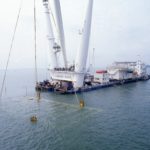
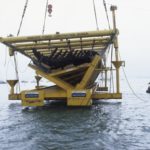
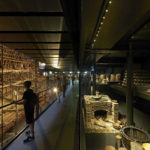
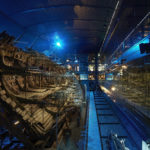
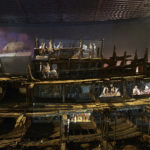
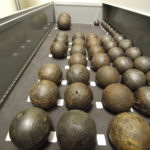
Festival of Archaeology
The anniversary celebrations also included the Festival of Archaeology. Through talks, special guests and hands-on activities, the museum team showcased the world's largest underwater excavation, aiming to inspire future archaeologists.
The festival's "Meet the Mary Rose divers" event enabled visitors to join some of the key members of the dive teams and hear first-hand about the trials and tribulations of excavating underwater.
To mark the 35th anniversary, the Mary Rose also hosted two days of lectures, featuring historians and underwater archaeologists.
Going ballistic — science meets conservation
Years earlier, divers had also raised more than 1,200 of the Mary Rose cannonballs from the seabed. But as seawater and iron are incompatible, corrosion had started to eat away at the metal, weakening the cannonballs' structure.
Fast forward to 2018 and a ground-breaking partnership between the Mary Rose Museum, University College London and Diamond Light Source. The Mary Rose's head of conservation Dr. Eleanor Schofield and her colleagues have been working at the cutting-edge of conservation science to protect and preserve the huge haul of cannonballs.
In a contradictory twist, however, the only way to uncover how to preserve the cannonballs has been to sacrifice the integrity of a few. The decision was made in June 2017 to cut a segment from less than 1 percent of the entire collection in order to save the rest.
The cut cannonballs were set in a resin and studied using the very bright light from a synchrotron, which reveals how iron changes as it rusts. This allows development of new protective techniques.
"People often ask me what science has to do with the Mary Rose; the answer is everything," says Dr. Schofield. "We need the detail Diamond offers because this process often starts at the cellular and molecular level. Science is a vital part of conservation, and it's great to know that we're playing our part in preserving our cultural heritage."
As such, the ship is an ongoing conservation project and divers involved in its recovery have helped raise magnificent Tudor treasures that continue to fascinate young and old alike. It is indeed a must-experience British icon, both enriching and entertaining. A world-class Tudor attraction, the Mary Rose is the like of which cannot be found anywhere else in the world.
By guest author Martin Macdonald
The post Celebrating the Anniversary of the Mary Rose appeared first on Scuba Diver Life.
from Scuba Diver Life https://ift.tt/2KoPbnE
Celebrating the Anniversary of the Mary Rose
As part of the 35th anniversary celebrations last year, divers who originally worked on the wreck of the Mary Rose in the 1970s and 1980s returned to the Mary Rose Museum for a special reunion. The famous Tudor ship sank in 1545, raised from the sea in 1982 by a team of dedicated divers.
Highlights of the reunion
For the first time since the wreck was out of the water, divers could see the whole internal structure of the Mary Rose without either the spraying system or drying tubes masking its structure.
Divers were able to look into the areas they excavated and see the ship’s Tudor artifacts — some of which they might have lifted themselves — displayed in the three long, mirror-image galleries opposite the ship. As they enjoyed dinner in one of the galleries, the divers could also observe the ship through the floor-to-ceiling windows.
Alex Hildred, now the Mary Rose Museum’s head of research and curator of ordnance and human remains, and Christopher Dobbs, head of interpretation and maritime archaeology, were among key staff who welcomed former colleagues from around the world. Old friends were some of the 500 divers who helped to excavate the ship. Even today, the project remains the largest underwater archaeological excavation ever undertaken.
The group reminisced about their shared experiences, focusing not only on the recovery of the ship but also on the discovery of thousands of Tudor objects contained inside.
“It was lovely to see so many of the old team, many of whom we hadn’t seen in years, if not decades,” says Hildred. “Diving on the wreck was always exciting, in spite of the poor underwater visibility and challenging conditions in the Solent. Our common goal at the time, the recovery of the Mary Rose, will forever bind the divers.”
“The recovery and subsequent raising of the Mary Rose were tremendously exciting to all of us who took part in the dives,” adds Dobbs. “The anniversary reunions not only enable us to look back at the past but also show that the Mary Rose project is a rich, ongoing project. We present the stories in the new museum in a way that is relevant to non-museum goers and to a twenty-first century audience.”







Festival of Archaeology
The anniversary celebrations also included the Festival of Archaeology. Through talks, special guests and hands-on activities, the museum team showcased the world’s largest underwater excavation, aiming to inspire future archaeologists.
The festival’s “Meet the Mary Rose divers” event enabled visitors to join some of the key members of the dive teams and hear first-hand about the trials and tribulations of excavating underwater.
To mark the 35th anniversary, the Mary Rose also hosted two days of lectures, featuring historians and underwater archaeologists.
Going ballistic — science meets conservation
Years earlier, divers had also raised more than 1,200 of the Mary Rose cannonballs from the seabed. But as seawater and iron are incompatible, corrosion had started to eat away at the metal, weakening the cannonballs’ structure.
Fast forward to 2018 and a ground-breaking partnership between the Mary Rose Museum, University College London and Diamond Light Source. The Mary Rose’s head of conservation Dr. Eleanor Schofield and her colleagues have been working at the cutting-edge of conservation science to protect and preserve the huge haul of cannonballs.
In a contradictory twist, however, the only way to uncover how to preserve the cannonballs has been to sacrifice the integrity of a few. The decision was made in June 2017 to cut a segment from less than 1 percent of the entire collection in order to save the rest.
The cut cannonballs were set in a resin and studied using the very bright light from a synchrotron, which reveals how iron changes as it rusts. This allows development of new protective techniques.
“People often ask me what science has to do with the Mary Rose; the answer is everything,” says Dr. Schofield. “We need the detail Diamond offers because this process often starts at the cellular and molecular level. Science is a vital part of conservation, and it’s great to know that we’re playing our part in preserving our cultural heritage.”
As such, the ship is an ongoing conservation project and divers involved in its recovery have helped raise magnificent Tudor treasures that continue to fascinate young and old alike. It is indeed a must-experience British icon, both enriching and entertaining. A world-class Tudor attraction, the Mary Rose is the like of which cannot be found anywhere else in the world.
By guest author Martin Macdonald
The post Celebrating the Anniversary of the Mary Rose appeared first on Scuba Diver Life.
from Scuba Diver Life https://ift.tt/2KoPbnE
Saturday, April 28, 2018
Diving as an Adaptive Buddy
Recreational scuba diving appeals to people of all backgrounds. Recently, scuba diving has appealed to people with physical challenges and disabilities, due to the lack of constraints they may feel underwater and to the social aspects of the sport and lifestyle. Our previous article examined how dive professionals can qualify to certify divers with disabilities. Here, we'll look at considerations for the recreational diver who dives regularly as an adaptive buddy.
Disabled divers may not generally need a dedicated guide unless conditions are quite challenging at a specific site. Often just having a buddy who understands a few specific procedures can be enough. Most people, while happy to help, might hesitate for fear of offending or saying the wrong thing to a disable diver. Usually, however, a certified diver with a physical challenge has been through rehabilitation. He or she is open-minded when it comes to assistance and how others perceive their injury.
A potential adaptive buddy can simply begin by asking if they need any additional assistance aside from the typical buddy check. Ask if their equipment differs in any way and how, for your own benefit as well. Here, we've outlined a few more things to note when it comes to diving as an adaptive buddy.
Surface assistance
On the boat or shore, a disabled diver will usually need the same or a bit more assistance as an able-bodied diver. They may need help gearing up or getting to the entry point to start the dive. They may also need a bit more time, so get ready in a shaded area and have lots of drinking water on hand, especially in warm, tropical locations. Divers with muscular dystrophy or paraplegics and amputees may prefer to don their gear at the water's surface.
If there are strong surface currents they may need assistance to keep from drifting at the surface, on the descent/ascent, and on the safety stop. The diver may also prefer to remove his gear when exiting the water, so be prepared to take it. They may also need minor assistance in pulling themselves onto the boat or support on a shore exit.
Divers with hearing issues will struggle with verbal warnings and alerts. Make sure they understand potential hazards via written cues during the dive briefing. Be extra observant underwater.
Underwater
Amputees, paraplegics, and divers with muscular dystrophy may have higher-than-normal air consumption rates if they need to work physically harder to swim underwater. If so, keep an eye on their air, particularly in currents. Help the diver with trim or buoyancy adjustments during the surface interval to improve air consumption on subsequent dives.
Forget the reflex to use hand clapping or tank bangers as an audio signal for deaf divers. Rather, observe in awe as two deaf divers have a coherent conversation underwater.
You can learn more about how to be an adaptive buddy in various agency training courses. In late 2017, PADI launched the Adaptive Support Diver course. Other organizations such as Disabled Divers International (DDI) offer courses as well.
Utila Dive Center has integrated the PADI/IAHD Adaptive Instructor program into its Instructor development training and offers Adaptive Dive partner training with PADI and IAHD as well.
The post Diving as an Adaptive Buddy appeared first on Scuba Diver Life.
from Scuba Diver Life https://ift.tt/2HA0JSZ
Diving as an Adaptive Buddy
Recreational scuba diving appeals to people of all backgrounds. Recently, scuba diving has appealed to people with physical challenges and disabilities, due to the lack of constraints they may feel underwater and to the social aspects of the sport and lifestyle. Our previous article examined how dive professionals can qualify to certify divers with disabilities. Here, we’ll look at considerations for the recreational diver who dives regularly as an adaptive buddy.
Disabled divers may not generally need a dedicated guide unless conditions are quite challenging at a specific site. Often just having a buddy who understands a few specific procedures can be enough. Most people, while happy to help, might hesitate for fear of offending or saying the wrong thing to a disable diver. Usually, however, a certified diver with a physical challenge has been through rehabilitation. He or she is open-minded when it comes to assistance and how others perceive their injury.
A potential adaptive buddy can simply begin by asking if they need any additional assistance aside from the typical buddy check. Ask if their equipment differs in any way and how, for your own benefit as well. Here, we’ve outlined a few more things to note when it comes to diving as an adaptive buddy.
Surface assistance
On the boat or shore, a disabled diver will usually need the same or a bit more assistance as an able-bodied diver. They may need help gearing up or getting to the entry point to start the dive. They may also need a bit more time, so get ready in a shaded area and have lots of drinking water on hand, especially in warm, tropical locations. Divers with muscular dystrophy or paraplegics and amputees may prefer to don their gear at the water’s surface.
If there are strong surface currents they may need assistance to keep from drifting at the surface, on the descent/ascent, and on the safety stop. The diver may also prefer to remove his gear when exiting the water, so be prepared to take it. They may also need minor assistance in pulling themselves onto the boat or support on a shore exit.
Divers with hearing issues will struggle with verbal warnings and alerts. Make sure they understand potential hazards via written cues during the dive briefing. Be extra observant underwater.
Underwater
Amputees, paraplegics, and divers with muscular dystrophy may have higher-than-normal air consumption rates if they need to work physically harder to swim underwater. If so, keep an eye on their air, particularly in currents. Help the diver with trim or buoyancy adjustments during the surface interval to improve air consumption on subsequent dives.
Forget the reflex to use hand clapping or tank bangers as an audio signal for deaf divers. Rather, observe in awe as two deaf divers have a coherent conversation underwater.
You can learn more about how to be an adaptive buddy in various agency training courses. In late 2017, PADI launched the Adaptive Support Diver course. Other organizations such as Disabled Divers International (DDI) offer courses as well.
Utila Dive Center has integrated the PADI/IAHD Adaptive Instructor program into its Instructor development training and offers Adaptive Dive partner training with PADI and IAHD as well.
The post Diving as an Adaptive Buddy appeared first on Scuba Diver Life.
from Scuba Diver Life https://ift.tt/2HA0JSZ
Optimal Places to Place a Bathroom
Content originally published and Shared from http://perfectbath.com
The battle for the bathroom is a common occurrence across homes throughout the world. Even people primarily living alone may run into this issue when hosting guests. When the issue about adding another bathroom to the house comes up, space and cost are usually the biggest concerns; but to the surprise of many, space isn’t as big of an issue as originally perceived.
A 3 by 5-foot area is usually all that is required to fit a toilet and sink. If you have a couple more feet to spare, a 5 by 5 can accommodate a small walk-in shower as well. Some common advantages of an additional bathroom can be convenience, adding value to your home, and the additional privacy of not having guests in your private bath.
Let’s look at where you can add a bathroom in the home – and where they are needed most.
Close to Living and Recreational Spaces
In a lot of homes, the placement of the bathroom is usually located closer to the bedrooms or in a central location between both living and sleeping spaces. The idea of having a bathroom close to the den or living room can be very attractive. And for the ultimate man cave, a toilet close by is an absolute necessity. It’s not uncommon to find a coat closet, staircase or hallway in or adjacent to a living space, as they can be the perfect spaces to install a half bath.
When hosting guests, it can be cumbersome to explain directions to the bathroom multiple times, especially if your home is larger or of unique design. Wouldn’t it be easier to just leave the door to your new bathroom open when unoccupied, so everyone can plainly see and take note when the urge to go arises?
Between Two Bedrooms
A convenient and efficient additional bathroom can be used to link two bedrooms together. This arrangement is commonly called a Jack and Jill style bathroom. This can be great for homes with children. Some well-designed Jack and Jill setups allow the use of private areas like the shower and toilet separate from the sink, counter and vanity area.
This style can be an efficient use of your space. Some standard bathrooms can even be converted in some home layouts. You can also save cash by incorporating this design compared to two separate bathrooms: why build and plumb another bathroom when you can frame in a door for less?
Split Your Pre-Existing Bathroom
This may seem like strange advice, but spend some time thinking about the size of your bathroom. Many homeowners possess bathrooms that can be much larger than necessary. Most of the plumbing has already been ran, allowing you to tap into water and drain pipes without making long and costly runs of pipe; this can be one of the major advantages of splitting your already existing bathroom. Though it sounds silly at first, making use of an over-sized bathroom by splitting it can give you the extra bathroom you need at a lower cost.
An additional bathroom is probably one of the most wished-for additions in smaller and older homes. Even in small homes, where it may seem unlikely to have the space, room can be found to make this addition. These optimal places for a new bathroom can potentially save time, frustration and money, depending on your exact configuration.
Contributed by: Perfectbath.com experts in bathroom design and bathroom fixtures.
The post Optimal Places to Place a Bathroom appeared first on Perfect Bath Canada.
from Perfect Bath Canada https://ift.tt/2Jz4c4X
Friday, April 27, 2018
Optimal Places to Place a Bathroom
Content originally published and Shared from http://perfectbath.com
The battle for the bathroom is a common occurrence across homes throughout the world. Even people primarily living alone may run into this issue when hosting guests. When the issue about adding another bathroom to the house comes up, space and cost are usually the biggest concerns; but to the surprise of many, space isn't as big of an issue as originally perceived.
A 3 by 5-foot area is usually all that is required to fit a toilet and sink. If you have a couple more feet to spare, a 5 by 5 can accommodate a small walk-in shower as well. Some common advantages of an additional bathroom can be convenience, adding value to your home, and the additional privacy of not having guests in your private bath.
Let's look at where you can add a bathroom in the home – and where they are needed most.
Close to Living and Recreational Spaces
In a lot of homes, the placement of the bathroom is usually located closer to the bedrooms or in a central location between both living and sleeping spaces. The idea of having a bathroom close to the den or living room can be very attractive. And for the ultimate man cave, a toilet close by is an absolute necessity. It's not uncommon to find a coat closet, staircase or hallway in or adjacent to a living space, as they can be the perfect spaces to install a half bath.
When hosting guests, it can be cumbersome to explain directions to the bathroom multiple times, especially if your home is larger or of unique design. Wouldn't it be easier to just leave the door to your new bathroom open when unoccupied, so everyone can plainly see and take note when the urge to go arises?
Between Two Bedrooms
A convenient and efficient additional bathroom can be used to link two bedrooms together. This arrangement is commonly called a Jack and Jill style bathroom. This can be great for homes with children. Some well-designed Jack and Jill setups allow the use of private areas like the shower and toilet separate from the sink, counter and vanity area.
This style can be an efficient use of your space. Some standard bathrooms can even be converted in some home layouts. You can also save cash by incorporating this design compared to two separate bathrooms: why build and plumb another bathroom when you can frame in a door for less?
Split Your Pre-Existing Bathroom
This may seem like strange advice, but spend some time thinking about the size of your bathroom. Many homeowners possess bathrooms that can be much larger than necessary. Most of the plumbing has already been ran, allowing you to tap into water and drain pipes without making long and costly runs of pipe; this can be one of the major advantages of splitting your already existing bathroom. Though it sounds silly at first, making use of an over-sized bathroom by splitting it can give you the extra bathroom you need at a lower cost.
An additional bathroom is probably one of the most wished-for additions in smaller and older homes. Even in small homes, where it may seem unlikely to have the space, room can be found to make this addition. These optimal places for a new bathroom can potentially save time, frustration and money, depending on your exact configuration.
Contributed by: Perfectbath.com experts in bathroom design and bathroom fixtures.
The post Optimal Places to Place a Bathroom appeared first on Perfect Bath Canada.
from Perfect Bath Canada https://ift.tt/2Jz4c4X
Blue Shark Diving in Rhode Island
In the warm(ish) summer waters of New England, 30 to 50 miles (50 to 80 km) off the coast of Rhode Island, divers will find some of the world’s best blue- and mako-shark diving. Although the waters still only range from 60 to 70 F (15 to 21 C), the blue shark diving in Rhode Island from June through September is worth the chill. The ocean here is bursting with life this time of year, filled with nourishment for the migrating sharks.
Blue shark diving in Rhode Island
Numerous shark-diving operators depart from southern New England harbors in search of these sleek predators. Many run cage-dives, which allow for a safe interaction. Several of them, however, offer the chance to swim with sharks outside the cage, offering divers the chance to experience the shark’s world in close proximity to the animals themselves.
Most Rhode Island shark charters attempt to lure the sharks with chum, although of course a sighting is not guaranteed. Most operators will wait for up to four hours on the water before making the long return to shore.
Although visibility can reach up to 80 feet (25 m) during the summer, plankton blooms frequently reduce clarity to an average of 40 feet (15 m). Divers often regard these emerald-tinted waters as the most exciting conditions, since you’ll rarely see the sharks approach until they’re quite close by.
Blue and mako sharks
It’s most common to see blue sharks on these dives, with the more-elusive mako shark a rarer spot. Blue sharks are impressive migrators, traveling across vast bands of the Atlantic throughout the year, from the waters off the United Kingdom coast all the way to the coast of Newfoundland.
They often aggregate in larger numbers than mako sharks, and divers will frequently spot up to 15 individuals on an hour-long dive. Blue sharks are scavengers, usually feeding off carcasses in the pelagic waters. Makos are predators, feeding on birds, tuna and other marine species. Makos don’t often aggregate to feed, and if divers are lucky they’ll see one or two of these bolts of lightning pumping through the water with their muscular body. The short-finned mako is the fastest shark in world, reaching speeds of up to 46 mph (74 kmph) to capture prey.
The New England coast offers a wide variety of other marine life as well. Divers may spot mola mola, tuna, billfish and even the rare dolphin either underwater or on the journey to the site. Even basking sharks, the second- largest fish in the ocean, sometimes inhabit Rhode Island waters during June and July.
The post Blue Shark Diving in Rhode Island appeared first on Scuba Diver Life.
from Scuba Diver Life https://ift.tt/2I48nGB
Blue Shark Diving in Rhode Island
In the warm(ish) summer waters of New England, 30 to 50 miles (50 to 80 km) off the coast of Rhode Island, divers will find some of the world's best blue- and mako-shark diving. Although the waters still only range from 60 to 70 F (15 to 21 C), the blue shark diving in Rhode Island from June through September is worth the chill. The ocean here is bursting with life this time of year, filled with nourishment for the migrating sharks.
Blue shark diving in Rhode Island
Numerous shark-diving operators depart from southern New England harbors in search of these sleek predators. Many run cage-dives, which allow for a safe interaction. Several of them, however, offer the chance to swim with sharks outside the cage, offering divers the chance to experience the shark's world in close proximity to the animals themselves.
Most Rhode Island shark charters attempt to lure the sharks with chum, although of course a sighting is not guaranteed. Most operators will wait for up to four hours on the water before making the long return to shore.
Although visibility can reach up to 80 feet (25 m) during the summer, plankton blooms frequently reduce clarity to an average of 40 feet (15 m). Divers often regard these emerald-tinted waters as the most exciting conditions, since you'll rarely see the sharks approach until they're quite close by.
Blue and mako sharks
It's most common to see blue sharks on these dives, with the more-elusive mako shark a rarer spot. Blue sharks are impressive migrators, traveling across vast bands of the Atlantic throughout the year, from the waters off the United Kingdom coast all the way to the coast of Newfoundland.
They often aggregate in larger numbers than mako sharks, and divers will frequently spot up to 15 individuals on an hour-long dive. Blue sharks are scavengers, usually feeding off carcasses in the pelagic waters. Makos are predators, feeding on birds, tuna and other marine species. Makos don't often aggregate to feed, and if divers are lucky they'll see one or two of these bolts of lightning pumping through the water with their muscular body. The short-finned mako is the fastest shark in world, reaching speeds of up to 46 mph (74 kmph) to capture prey.
The New England coast offers a wide variety of other marine life as well. Divers may spot mola mola, tuna, billfish and even the rare dolphin either underwater or on the journey to the site. Even basking sharks, the second- largest fish in the ocean, sometimes inhabit Rhode Island waters during June and July.
The post Blue Shark Diving in Rhode Island appeared first on Scuba Diver Life.
from Scuba Diver Life https://ift.tt/2I48nGB
EU moves to regulate OTAs business practices
In addition to tech giants like Google, Apple and Amazon, the new rules will specifically target hotel booking websites such as Expedia and Booking.com, requiring them to be more transparent about how they rank search results and why they delist some services.
from HOTELMARKETING.COM https://ift.tt/2FmaoLc
Hilton CEO outlines tiered pricing plan, defends commission cut
Hilton CEO Christopher Nassetta outlined his company's plans to expand its tiered pricing structure designed to reduce cancellations and defended Hilton's cut in the group commission rate.
from HOTELMARKETING.COM https://ift.tt/2I3HpyD
Carlson Wagonlit Travel sees growth after ‘year of digital transformation’
Carlson Wagonlit Travel saw total transaction volume rise by 3.6% last year to $23.2 billion in the first full year of its 'CWT 3.0' digital transformation strategy. The introduction of hotel distribution business RoomIt helped push hotel revenue up by 13%.
from HOTELMARKETING.COM https://ift.tt/2FlzV7b
Marriott launches global customer recognition platform powered by Salesforce
The platform enables Marriott to conduct one, continuous interaction with members of its loyalty programs across guest channels including call centers, on-property, web and mobile, on a global scale.
from HOTELMARKETING.COM https://ift.tt/2I2UdFw
Gmail Redesign: 5 things marketers need to know
Google has roughly 1.2 billion Gmail users, making up 20 percent of the global email client share in 2016. If you're an email marketer, it's likely you're regularly connecting with customers who use the G-Suite.
from HOTELMARKETING.COM https://ift.tt/2Fny29Y
Study: Google, TripAdvisor and Brand.com equally important to driving direct hotel bookings
Hoteliers deem Google, TripAdvisor and their own Brand.com website as equally successful to driving direct bookings, according to a new report from SiteMinder.
from HOTELMARKETING.COM https://ift.tt/2I3HkLl
A revenue manager’s daily checklist
The job description may vary from hotel to hotel, but one thing that stays the same is the ability to optimise profit and increase ADR for the hotel. So, what are the key morning to-dos for all Revenue Managers?
from HOTELMARKETING.COM https://ift.tt/2HyAHj0
Expedia bookings and revenue grow 15%
Yet, Expedia's days of torrid growth may be behind it. The company is having to spend more every quarter without enjoying the jumps in revenue that used to follow that investment.
from HOTELMARKETING.COM https://ift.tt/2HuCp9i
Thursday, April 26, 2018
Caribbean Coral Roundup: Cactus Coral
Bright, multicolored cactus coral grows in every habitat from the shallowest to the deepest parts of the reef and make the perfect subjects for coral photography. Once scuba divers and snorkelers know what to look for, they should have no problem identifying these corals.
Cactus corals grow into thick, encrusting plates or large domes and are fairly common throughout the Caribbean. And they only grow in the Caribbean — nowhere else in the world.
There are five species: knobby cactus coral (Mycetophyllia aliciae); low-ridge cactus coral (Mycetophyllia danaana); rough cactus coral (Mycetophyllia ferox); ridged cactus coral (Mycetophyllia lamarckiana); and (Mycetophyllia reesi). The last coral, M. reesi, is a ridge-less deep-water species. Here we'll focus on the first four.
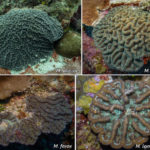
Telling the species apart is less important than just being able to identify this type of coral. If you're new to coral identification, here are a few introductory articles to learn the basics of coral identification and helpful terms.
Knobby cactus coral (Mycetophyllia aliciae)
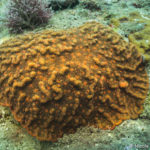
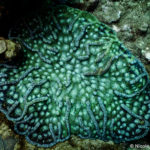
This one gets its name from the short knobs that develop in the center of the coral. You can also distinguish this coral by looking at the white marking that resembles flowers surrounding each polyp.
Perhaps the most important feature, and what sets this coral apart from other Mycetophyllia species, is the number of corallites between each ridge. If you find two or more rows of polyps between ridges, the coral is most likely a knobby cactus coral. Other Mycetophyllia species typically have one row of polyps, or two sets of polyps near the edges in younger developing colonies.
Low-ridge cactus coral (Mycetophyllia danaana)
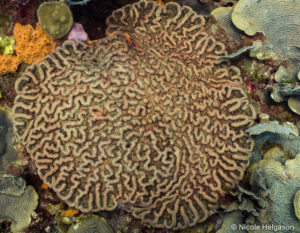
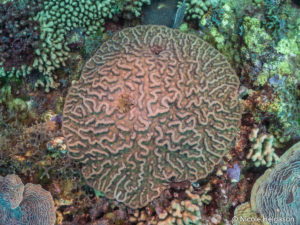
This coral forms round plates with low ridges. The coral is thicker in the center of the colony tapering to a narrow perimeter. The low-ridge cactus coral is the chunkiest of the Mycetophyllia species.
This coral's ridges can connect in the center of the coral, forming long, meandering valleys. The ridges can also break apart, forming little nodes called monticules. It can be challenging to differentiate between species of Mycetophyllia. While some will be clearly distinctive, others straddle the line between two species, especially between the low-ridge and ridged cactus coral.
Rough cactus coral (Mycetophyllia ferox)
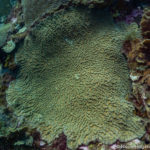
Spot rough cactus coral tucked into caves or on the side of rocks, particularly on dives deeper than 30 feet (10 m). This species forms thin plates with narrow valleys and short ridges that often connect around polyp mouths. This is the only Mycetophyllia species that has ridges that connect around polyps.
Ridged Cactus Coral (Mycetophyllia lamarckiana)
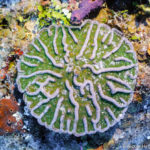
The ridged cactus corals have distinct scalloped edges and continuous ridges that run from the edge of the colony toward the center. The ridges, however, do not connect in the center, which is a distinguishing characteristic of this species.
Coral identification is not easy, and it can be tricky to tell these four species apart. It's easy to mistake small colonies of ridged cactus coral for low-ridge cactus coral. Some scientists think ridged cactus coral could just be juvenile low-ridge cactus corals that haven't developed their full skeletal ridges. It's most important to recognize the coral as part of the right family by looking for the fleshy surface and bright, colorful patterns.
To learn more about Caribbean corals with a detailed description of each one check out this guide to Caribbean corals.
The post Caribbean Coral Roundup: Cactus Coral appeared first on Scuba Diver Life.
from Scuba Diver Life https://ift.tt/2vQRs7K
Caribbean Coral Roundup: Cactus Coral
Bright, multicolored cactus coral grows in every habitat from the shallowest to the deepest parts of the reef and make the perfect subjects for coral photography. Once scuba divers and snorkelers know what to look for, they should have no problem identifying these corals.
Cactus corals grow into thick, encrusting plates or large domes and are fairly common throughout the Caribbean. And they only grow in the Caribbean — nowhere else in the world.
There are five species: knobby cactus coral (Mycetophyllia aliciae); low-ridge cactus coral (Mycetophyllia danaana); rough cactus coral (Mycetophyllia ferox); ridged cactus coral (Mycetophyllia lamarckiana); and (Mycetophyllia reesi). The last coral, M. reesi, is a ridge-less deep-water species. Here we’ll focus on the first four.

Telling the species apart is less important than just being able to identify this type of coral. If you’re new to coral identification, here are a few introductory articles to learn the basics of coral identification and helpful terms.
Knobby cactus coral (Mycetophyllia aliciae)


This one gets its name from the short knobs that develop in the center of the coral. You can also distinguish this coral by looking at the white marking that resembles flowers surrounding each polyp.
Perhaps the most important feature, and what sets this coral apart from other Mycetophyllia species, is the number of corallites between each ridge. If you find two or more rows of polyps between ridges, the coral is most likely a knobby cactus coral. Other Mycetophyllia species typically have one row of polyps, or two sets of polyps near the edges in younger developing colonies.
Low-ridge cactus coral (Mycetophyllia danaana)


This coral forms round plates with low ridges. The coral is thicker in the center of the colony tapering to a narrow perimeter. The low-ridge cactus coral is the chunkiest of the Mycetophyllia species.
This coral’s ridges can connect in the center of the coral, forming long, meandering valleys. The ridges can also break apart, forming little nodes called monticules. It can be challenging to differentiate between species of Mycetophyllia. While some will be clearly distinctive, others straddle the line between two species, especially between the low-ridge and ridged cactus coral.
Rough cactus coral (Mycetophyllia ferox)

Spot rough cactus coral tucked into caves or on the side of rocks, particularly on dives deeper than 30 feet (10 m). This species forms thin plates with narrow valleys and short ridges that often connect around polyp mouths. This is the only Mycetophyllia species that has ridges that connect around polyps.
Ridged Cactus Coral (Mycetophyllia lamarckiana)

The ridged cactus corals have distinct scalloped edges and continuous ridges that run from the edge of the colony toward the center. The ridges, however, do not connect in the center, which is a distinguishing characteristic of this species.
Coral identification is not easy, and it can be tricky to tell these four species apart. It’s easy to mistake small colonies of ridged cactus coral for low-ridge cactus coral. Some scientists think ridged cactus coral could just be juvenile low-ridge cactus corals that haven’t developed their full skeletal ridges. It’s most important to recognize the coral as part of the right family by looking for the fleshy surface and bright, colorful patterns.
To learn more about Caribbean corals with a detailed description of each one check out this guide to Caribbean corals.
The post Caribbean Coral Roundup: Cactus Coral appeared first on Scuba Diver Life.
from Scuba Diver Life https://ift.tt/2vQRs7K
